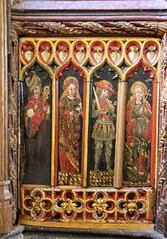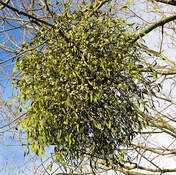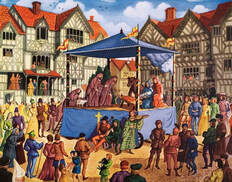
Like so many other traditions, the exact origins of red and green as the colors of Christmas are lost in time. Despite a variety of theories, it is clear the tradition didn’t evolve as part of the Christian religion, but can be traced to the ancient Celtic peoples who commemorated different holidays, usually related to the change of seasons, with different colors.
They venerated the green holly with red berries for being evergreen during the cold winter and believed the plant was meant to keep the world beautiful even in the winter. Decorating their homes with holly for the winter solstice celebrations was believed to protect them and bring good luck in the coming year. Celtic peoples as well as many other pagan religions celebrated winter with evergreens.
Even the Romans used Fir Trees to decorate their temples at the festival of Saturnalia celebrated at What is now Christmas time.

Most Christians understand that Christ was not born on what we now call December 25th. The scriptures don’t identify the season although there are indicators that he may have been born in the spring time because Luke references sheep grazing in the fields, which only happened in warmer months.

THE MIDDLE AGES
During the Middle Ages, after the fall of Rome, not many people celebrated Christmas. However, during this period many Celtic and other pagan traditions and celebrations were subsumed by Christian beliefs and practices.
After a month of fasting (Advent) and preparation, the Christmas festivities lasted for 12 days, from Christmas to January 6 (Epiphany). Replicating the pagan traditions, “inversions of order occurred across medieval society around Christmas. One of the most colorful was the election of a boy bishop, who presided over processions and church ritual on the Feast of the Holy Innocents (28 December).
In a surviving example of a boy bishop’s sermon, the boy bishop wishes that all his schoolteachers would end up on the gallows at Tyburn. One chronicle records how, at the Abbey of St Gall in the 10th century, King Conrad tried to distract the procession of the boys by strewing apples down the processional route; the boys were, however, so disciplined that not an apple was touched.”
https://www.historyextra.com/medieval-christmas
ROOD SCREENS
Dr. Spike Bucklow of the University of Cambridge, who studied medieval church art, hypothesizes that the uses of green and red started with the 14th century Rood Screen.
That was a new one. I didn’t know that Rood Screens are wooden structures that stand in a church between the nave and the chancel, partitions installed in churches to separate the congregation from the priest and the altar.

◄15th century rood screen, Holy Trinity Church, in Torbryan, Devon, southwestern England
Photo source: http://www.thehistoryblog.com/archives/26607
SIGNIFICANCE OF GREEN AND RED
Regardless of the origins, each of the colors has accumulated traditional beliefs which still predominates today.

● Green signifies life - Plants are green because they depend on chlorophyll for life. Thus, to many societies the color green symbolizes life, fertility, and the rebirth of life after winter. About two hundred years before the birth of Christ mistletoe was used by the Druids to celebrate the coming of winter. Green is an ancient reminder that winter doesn’t last forever.
● Christian belief - The color green is a natural representation of eternal life, specifically the evergreen tree and how it survives through the winter season. That’s why, in Christian belief, green represents the eternal life that Jesus Christ offers.

◄Pagan Wedding Dress: Photo source: https://wiccanspells.info/wiccan-pagan-articles/4-beautiful-pagan-wedding-dress-styles/
McMillian Education Poster – Painting by unknown 20th century artist of a Miracle Play
Photo source: https://bookpalace.com/acatalog/info_20thMiraclePlLL.html ▼

The tradition was to present the Paradise Play, the story of Adam and Eve and the Garden of Eden. The Paradise Tree within the garden was normally a pine tree with red apples tied to it. That inspired people to decorate their homes with evergreen bows and decorating with red apples.

● Red Berries signify fertility and new life – Holly is one of the plants that remains green during the winter and it happens to have red barriers. Berries, because they carry the seeds for new plants, could be symbolic of fertility and new life. Mistletoe has green berries. Go figure.

● Paradise or Miracle Plays of the 14th century – The association of red with these play comes from the story of the apple tree and the apples tied to the evergreen.


 RSS Feed
RSS Feed